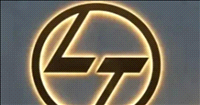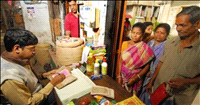States want more from centre as GST looms
22 Jan 2009
The global financial crisis has given an opportunity for state governments to demand an extra Rs 20,000 crore from the union as a special grant towards planned expenditure on irrigation, roads and other infrastructure projects in rural areas. At the same time, they have questioned the need for globalisation ''without social restraint'' and sought a meeting with Prime Minister Manmohan Singh for a reorientation of such ''one-sided'' policies.
At a meeting of the empowered group of state finance ministers on value added tax (VAT) in New Delhi, the states hailed the second stimulus package facility to mop up an additional Rs.30,000 crore through market borrowings, but said this would not be enough to offset the falling revenues from VAT.
Thanks to the global meltdown, the growth rate of VAT revenue up to December this fiscal has plunged to 12 per cent, compared to trend growth rates of about 22 per cent in earlier years. Moreover, the states also propose to seek certain clarifications from the centre on the additional market borrowing announcement.
The empowered group, which includes representatives of the union government, feared that they would lose the benefits of debt waiver if the additional market borrowings were to result in an inability to meet their fiscal responsibility and budget management (FRBM) targets.
GST in the offing: The empowered committee has also decided that petroleum products should, in the first stage, be kept out of the proposed goods and services tax (GST) system which is to be implemented from April 2010, as the prices are not market-determined. There is also likely to be a dual GST structure, with a central GST separate from a state GST.
Under GST, both the centre and the states will have powers to tax goods and services. At present, the states cannot tax services.
GST will subsume central excise, service tax, state sales tax and central sales tax. At present, there is a rather complex structure - central excise rates are 10 per cent, eight per cent and four per cent, the service tax rate is 12 per cent, state sales tax rates are 12.5 per cent and four per cent, while the central sales tax rate is tow per cent.
The revenue-neutral rates will be determined after calculating the revenue loss to states under the new system and additional income from tax on services.
The single GST rate structure will benefit both the Centre and the states. The scope of service tax will be expanded to all services. At present, many services remain untaxed. However, some states like Punjab and Haryana still oppose some aspects of the proposal.
On similar lines, area-based exemptions to industry will be phased out, along with common and minimal number of goods and services.
West Bengal finance minister Asim Dasgupta, chairman of the empowered committee, told reporters after the meeting that the centre should also provide a state-wise list and quantum of additional market borrowing that would be permitted within the overall ceiling of Rs 30,000 crore for this fiscal.
Dasgupta said: ''This one-sided globalisation without any social restraint has created problems for the first world countries and, in terms of impact, for the Indian states as well. All components of globalisation should be totally reviewed. We will be discussing this with the Prime Minister.''
''All those things with which we have been sermonised over the years have landed us in this situation. All these things have to be reviewed openly,'' Dasgupta said, adding that the sixth pay commission recommendations have added to the financial burden of state governments.
He said the structure would only take firm shape after states panel meets the prime minister. ''But I can tell you that there would be very few rates,'' he said, adding that large number of both central and state-level taxes would be subsumed within the GST system.
Dasgupta said rates are expected to be finalised by March. A state government official who attended the meeting is reported to have said that states would not agree to anything less than 50 per cent of the tax. He said the rate would range from 16-20 per cent, with the centre and state taking eight to 10 per cent each.
On the issue of pay revision of state government employees, Dasgupta insisted that the centre should bear half of the additional burden for 2008-09 and 2009-10, after which the 13th Finance Commission would be created.






























